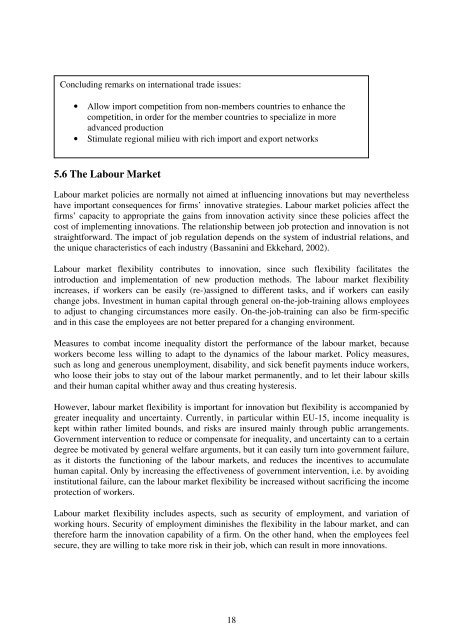INNOVATION POLICY INSTRUMENTS
INNOVATION POLICY INSTRUMENTS
INNOVATION POLICY INSTRUMENTS
You also want an ePaper? Increase the reach of your titles
YUMPU automatically turns print PDFs into web optimized ePapers that Google loves.
Concluding remarks on international trade issues:<br />
• Allow import competition from non-members countries to enhance the<br />
competition, in order for the member countries to specialize in more<br />
advanced production<br />
• Stimulate regional milieu with rich import and export networks<br />
5.6 The Labour Market<br />
Labour market policies are normally not aimed at influencing innovations but may nevertheless<br />
have important consequences for firms’ innovative strategies. Labour market policies affect the<br />
firms’ capacity to appropriate the gains from innovation activity since these policies affect the<br />
cost of implementing innovations. The relationship between job protection and innovation is not<br />
straightforward. The impact of job regulation depends on the system of industrial relations, and<br />
the unique characteristics of each industry (Bassanini and Ekkehard, 2002).<br />
Labour market flexibility contributes to innovation, since such flexibility facilitates the<br />
introduction and implementation of new production methods. The labour market flexibility<br />
increases, if workers can be easily (re-)assigned to different tasks, and if workers can easily<br />
change jobs. Investment in human capital through general on-the-job-training allows employees<br />
to adjust to changing circumstances more easily. On-the-job-training can also be firm-specific<br />
and in this case the employees are not better prepared for a changing environment.<br />
Measures to combat income inequality distort the performance of the labour market, because<br />
workers become less willing to adapt to the dynamics of the labour market. Policy measures,<br />
such as long and generous unemployment, disability, and sick benefit payments induce workers,<br />
who loose their jobs to stay out of the labour market permanently, and to let their labour skills<br />
and their human capital whither away and thus creating hysteresis.<br />
However, labour market flexibility is important for innovation but flexibility is accompanied by<br />
greater inequality and uncertainty. Currently, in particular within EU-15, income inequality is<br />
kept within rather limited bounds, and risks are insured mainly through public arrangements.<br />
Government intervention to reduce or compensate for inequality, and uncertainty can to a certain<br />
degree be motivated by general welfare arguments, but it can easily turn into government failure,<br />
as it distorts the functioning of the labour markets, and reduces the incentives to accumulate<br />
human capital. Only by increasing the effectiveness of government intervention, i.e. by avoiding<br />
institutional failure, can the labour market flexibility be increased without sacrificing the income<br />
protection of workers.<br />
Labour market flexibility includes aspects, such as security of employment, and variation of<br />
working hours. Security of employment diminishes the flexibility in the labour market, and can<br />
therefore harm the innovation capability of a firm. On the other hand, when the employees feel<br />
secure, they are willing to take more risk in their job, which can result in more innovations.<br />
18
















